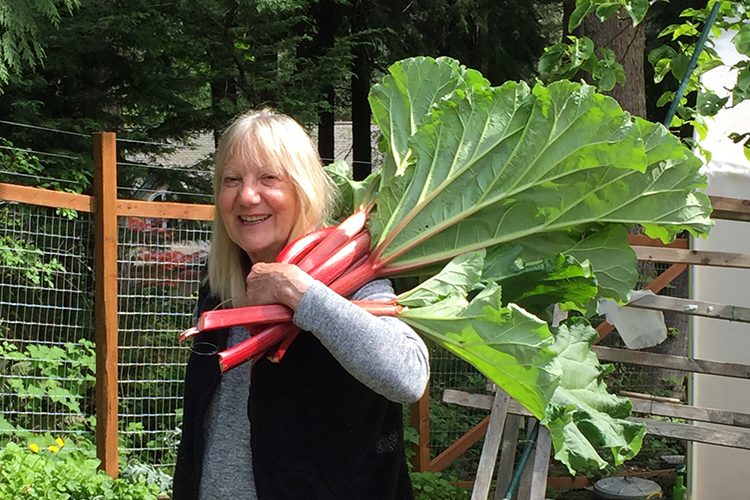Shirley and her Rhubarb
Posted by Shirley Metz
in Of Interest
When Peter and I first moved to Washington’s Olympic Peninsula 30 years ago, we started an organic vegetable garden on our coastal property surrounded by forest. As those who garden know, the culture of ornamentals, flowers, fruits, and vegetables demands near daily attendance. Up until recently we traveled up to 9 months each year, mainly leading expeditions. But with Peter’s time required at our home office to complete his new Seabirds Handbook, our travels became fewer which gave me a chance to catch up with the garden planning.
And now, banished @Home, and sequestered in place, I have had even more opportunity to garden like never before. I redesigned the vegetable garden to accommodate four greenhouses, added additional raised beds, enclosed it entirely in deer-proof fencing, laid out pathways, built potting tables, brought in yards and yards of compost, amended soils—and, well, did everything one must do to bring on a garden. Experimenting with different varieties of seeds obtained from organic suppliers, the vegetable and ornamental garden has been producing like crazy.
Interestingly, it is some of the original vegetable plantings of 30 years ago that never fail to amaze me! There are only a few vegetable species that propagate continuously and do not need to be seeded each year. The perennials, asparagus and artichoke are two; another is rhubarb.
Sometimes called the “pie plant,” rhubarb (Rheum rhabarbarum) is an herbaceous perennial plant which grows from thick, short rhizomes. Ben Franklin is credited with being one of the first to send rhubarb seeds to the American colonies and in previous centuries, rhubarb was cultivated almost solely for its medicinal uses. The leaves are toxic as they contain oxalic acid, but the fresh stalks are low in calories and fat, cholesterol free, high in fiber, and contain vitamin A, potassium, and calcium.
There are different varieties of rhubarb which produce different shades of red to pink to greenish stalks, all which can be cooked, stewed, or baked. Rhubarb can be used in breakfast, lunch, and dinner recipes. How about Rhubarb Chile or Rhubarbecue using rhubarb, strawberries, and boneless country-style pork ribs? Eat it raw by dipping the stalk in sugar, honey, or salt.
Rhubarb freezes easily which allows for year-round use. A recipe I use almost every week is for a fruit ‘crumble’ of sorts. Depending on what fruits I have ready for harvest, I include apple and pear slices plus berries to the rhubarb cut in 1 inch pieces, chopped nuts, sunflower and pumpkin seeds, milled flax, wheat germ, plus ‘whatever.’ Top the fruit mixture with uncooked cooking oats to which I have added cinnamon, ginger, and nutmeg. Bake at 375 degrees for about an hour. Serve with a topping of plain yogurt. Is it breakfast or dessert?
You may think that the rhubarb stalks on my shoulders are quite large. However, if you have been with us on our Britain voyage, you will have seen on some of the elegant estates the Gunnera manicata ornamental rhubarb. Sometimes called the “dinosaur plant”, it can grow 6-12 feet tall given the right boggy conditions.
And what kind of fertilizer do I use? Hint: the answer is in Peter’s new seabird book!


That bunch of rhubarb looks ready for a Strawberry and Rhubarb pie. I enjoy reading all the snippets from Apex. Thanks for sharing.
I can’t believe how big they look and to think another type grows even larger! YIKES!! Your garden sounds glorious and the recipe delicious. Thank you for sharing.
Enjoyed the post. Sounds like you’ve kept busy…Take care. Martha and Jim Foght